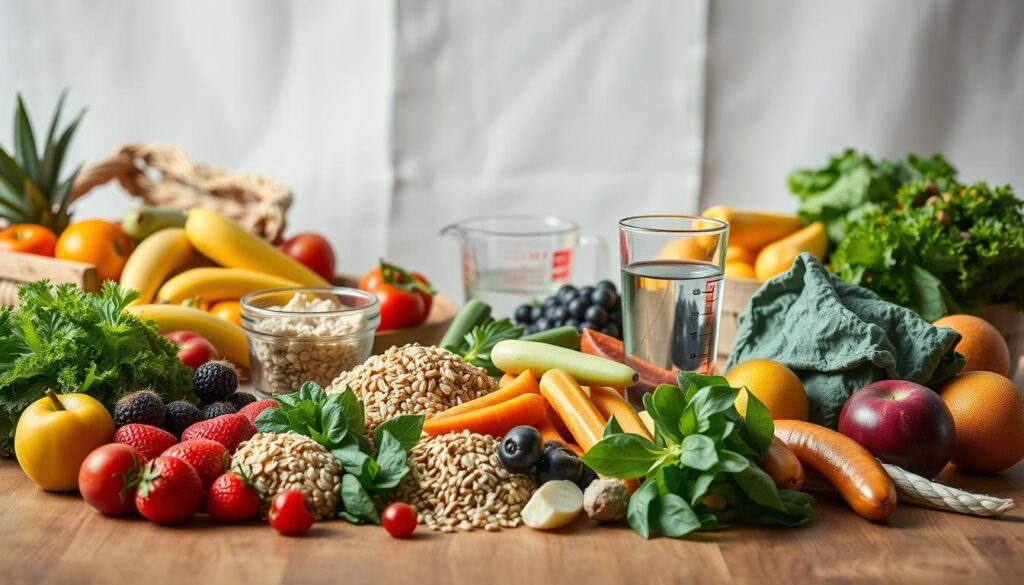Lose Weight the Right Way: 7 Healthy Tips for You
Embarking on a weight loss journey can be challenging, but with the right mindset and approach, you can achieve your goals. Adopting a healthier lifestyle is not just about reaching a certain number on the scale; it’s about making sustainable changes that you can maintain in the long term.
By focusing on balanced lifestyle changes rather than quick fixes, you’ll be on your way to a healthier, happier you. This article will guide you through practical advice on how to detox your body naturally at home and adopt habits that promote overall well-being.
Key Takeaways
- Understand the importance of a balanced lifestyle for weight loss
- Learn how to make sustainable changes to your diet and exercise routine
- Discover practical tips for detoxing your body naturally at home
- Explore the benefits of adopting a healthier lifestyle
- Get started on your weight loss journey with confidence
Understanding Healthy Weight Loss
Healthy weight loss is not just about shedding pounds, but about adopting a sustainable lifestyle. To achieve your weight loss goals, it’s crucial to understand the principles behind healthy weight loss.
The Difference Between Healthy and Unhealthy Weight Loss
Healthy weight loss focuses on losing fat, not muscle or water. Crash diets and extreme calorie restriction can lead to unhealthy weight loss, often resulting in nutrient deficiencies and a higher risk of weight regain. In contrast, healthy weight loss involves making sustainable dietary changes and increasing physical activity.
Setting Realistic Weight Loss Goals
Setting realistic goals is key to successful weight loss. This involves understanding the difference between short-term and long-term goals, as well as knowing the healthy rate of weight loss.
Short-term vs. Long-term Goals
Short-term goals provide immediate motivation, while long-term goals help you stay on track. For example, a short-term goal might be to lose 5 pounds in a month, while a long-term goal could be to lose 20 pounds in 6 months.
The Healthy Rate of Weight Loss
Aiming to lose 1-2 pounds per week is considered a healthy and sustainable rate of weight loss. This may seem slow, but it’s more likely to result in lasting weight loss.
| Weight Loss Rate | Expected Loss per Week | Sustainability |
|---|---|---|
| Healthy | 1-2 pounds | High |
| Unhealthy | More than 2 pounds | Low |
By understanding and adopting healthy weight loss methods, such as métodos naturais de desintoxicação, you can achieve a healthy weight loss that lasts. Remember, the goal is to make sustainable lifestyle changes, not just to lose weight quickly.
Why Crash Diets Don’t Work
Crash diets may promise quick weight loss, but they often lead to more harm than good in the long run. The temptation to try these diets can be strong, especially when you’re eager to see results. However, it’s essential to understand the risks associated with extreme calorie restriction and the benefits of making sustainable lifestyle changes.
The Dangers of Extreme Calorie Restriction
Crash diets often involve drastically cutting calories, which can lead to nutrient deficiencies and a range of health problems. When you severely restrict your calorie intake, your body may not get the nutrients it needs to function properly. This can result in fatigue, weakness, and poor overall health.
- Nutrient deficiencies due to inadequate diet
- Decreased metabolism as the body goes into “starvation mode”
- Increased risk of eating disorders
Metabolic Adaptations to Severe Dieting
When you drastically cut calories, your metabolism slows down to conserve energy. This makes it harder to lose weight and easier to gain it back once you return to your normal eating habits. It’s a vicious cycle that can be challenging to break.
The Importance of Sustainable Changes
Instead of relying on quick fixes, focus on making sustainable lifestyle changes. This includes adopting a balanced diet and incorporating regular physical activity into your routine. By building habits that last, you’ll be more likely to maintain your weight loss over time.
Building Habits That Last
To achieve long-term weight loss success, it’s crucial to develop habits that you can maintain. This includes eating a variety of nutrient-dense foods and staying hydrated. You can also explore natural detox methods, such as incorporating remédios caseiros para desintoxicar seu corpo into your routine, to support your overall health.

7 Simple Tips to Start Losing Weight in a Healthy Way
Losing weight in a healthy way is not just about cutting calories; it’s about adopting a holistic lifestyle change. This approach focuses on sustainable habits that not only help you lose weight but also improve your overall well-being. The 7 tips outlined in this section are designed to work together to help you achieve your weight loss goals.
The Foundation of Successful Weight Loss
A successful weight loss journey is built on a foundation of healthy habits, including a balanced diet, regular physical activity, and a positive mindset. By focusing on these core elements, you can create a sustainable weight loss plan that works for you. For instance, incorporating desintoxicação corporal em casa practices, such as drinking plenty of water and eating nutrient-rich foods, can support your weight loss efforts.
| Healthy Habit | Benefits |
|---|---|
| Balanced Diet | Provides essential nutrients, supports weight loss |
| Regular Physical Activity | Burns calories, improves cardiovascular health |
| Positive Mindset | Reduces stress, enhances motivation |
How These Tips Work Together
The 7 tips provided are designed to be complementary, working together to help you achieve your weight loss goals. By creating a balanced eating plan, increasing your physical activity, and managing stress effectively, you can create a comprehensive weight loss strategy. As
“The key to successful weight loss is not just about dieting, but about making sustainable lifestyle changes.”
This holistic approach ensures that you not only lose weight but also maintain your weight loss over time.
By understanding how these tips work together, you can tailor your weight loss plan to suit your needs, ensuring a more successful and sustainable journey.
Tip1: Create a Balanced Eating Plan
A balanced eating plan is the cornerstone of a healthy weight loss strategy. By focusing on nutrient-dense foods and understanding your nutritional needs, you can create a balanced eating plan that supports your weight loss goals and overall health.

Understanding Macronutrients
To develop an effective eating plan, it’s essential to understand the role of macronutrients: protein, fats, and carbohydrates. Each plays a unique role in your body’s functioning and weight management.
Protein, Fats, and Carbohydrates
Protein is crucial for muscle repair and growth. Fats are essential for hormone production and energy storage, while carbohydrates provide energy for your daily activities. A balanced diet includes the right proportions of these macronutrients.
Finding Your Ideal Macro Balance
Finding the ideal balance depends on your individual needs, activity level, and weight loss goals. For instance, a person engaging in regular physical activity may require more protein to support muscle growth.
| Macronutrient | Function | Example Foods |
|---|---|---|
| Protein | Muscle repair and growth | Chicken, fish, beans |
| Fats | Hormone production, energy | Nuts, olive oil, avocados |
| Carbohydrates | Energy source | Rice, bread, fruits |
Portion Control Strategies
Understanding portion control is vital for maintaining a balanced eating plan. It helps prevent overeating and ensures you’re fueling your body appropriately.
Using Visual Cues
One effective strategy is using visual cues. For example, comparing the portion size of meat to the palm of your hand can help gauge the right amount.
Mindful Eating Practices
Mindful eating involves paying attention to your hunger and fullness cues, eating slowly, and savoring your food. This practice can significantly enhance your relationship with food and support your weight loss journey.
By incorporating these strategies into your daily routine, you can develop a healthier eating habit that supports your overall well-being and aids in achieving your weight loss goals. Whether you’re looking for “dicas de desintoxicação em casa” or tips on creating a “plano de dieta detox em casa,” starting with a balanced eating plan is a step in the right direction.
Tip2: Increase Your Physical Activity
Increasing your physical activity can significantly enhance your weight loss journey. Regular exercise not only burns calories but also builds muscle, improves metabolism, and enhances overall health. By finding activities you enjoy and incorporating them into your daily routine, you can make sustainable lifestyle changes that support your weight loss goals.
Finding Exercise You Enjoy
The key to maintaining a consistent exercise routine is finding activities that you genuinely enjoy. This could be anything from cardio exercises like running or cycling to strength training or low-impact activities such as yoga or Pilates.
Cardio vs. Strength Training
Both cardio and strength training have their benefits. Cardio exercises are excellent for burning calories and improving cardiovascular health, while strength training helps build muscle mass, which can further boost your metabolism.
Low-Impact Options for Beginners
If you’re new to exercise or have mobility issues, low-impact activities like swimming, walking, or yoga can be a great starting point. These exercises are easier on the joints and can be just as effective in improving your fitness levels.

Building a Consistent Workout Routine
Consistency is crucial when it comes to exercise. Building a routine that you can stick to in the long term is more effective than trying to do too much too soon.
Starting Small and Progressing
Begin with manageable sessions and gradually increase the intensity and duration as you become more comfortable. This approach helps prevent burnout and reduces the risk of injury.
Incorporating Movement Throughout Your Day
In addition to dedicated workout sessions, look for opportunities to be more active throughout the day. Simple changes like taking the stairs instead of the elevator or going for a short walk during your lunch break can make a significant difference.
Tip3: Stay Hydrated Throughout the Day
Staying hydrated is a simple yet effective way to support your weight loss journey. Drinking enough water is essential for overall health, and it plays a significant role in your weight loss efforts. When you don’t drink enough water, your body may struggle to function optimally, which can slow down your metabolism and make it harder to lose weight.

How Water Supports Weight Loss
Water is crucial for boosting your metabolism. Even mild dehydration can cause a decrease in metabolic rate, making it more challenging to lose weight. Here are some ways water supports weight loss:
- Water’s Role in Metabolism: Drinking water can help increase your resting metabolic rate, which is the number of calories your body burns at rest.
- Distinguishing Thirst from Hunger: Sometimes, thirst can be mistaken for hunger. Drinking water can help reduce unnecessary snacking.
Tips for Increasing Your Water Intake
Increasing your water intake can be achieved through simple strategies. Here are some tips to help you stay hydrated:
- Flavoring Options Without Added Sugar: Add slices of lemon, lime, or cucumber to your water for a refreshing taste without adding calories.
- Setting Hydration Reminders: Use a water tracking app or set reminders on your phone to drink water throughout the day.
By incorporating these tips into your daily routine, you can stay hydrated and support your weight loss efforts. Remember, hydration is a key component of overall health and well-being.
Tip4: Prioritize Quality Sleep
A good night’s sleep can make a significant difference in your weight loss efforts. Quality sleep is essential for overall health, and it plays a crucial role in weight management. When you don’t get enough sleep, it can affect your body’s ability to regulate hunger and fullness hormones, leading to overeating and poor food choices.
The Connection Between Sleep and Weight
Sleep deprivation can have a significant impact on your weight loss journey. When you don’t get enough sleep, your body produces more ghrelin, the hunger hormone, and less leptin, the fullness hormone. This hormonal imbalance can lead to increased cravings for unhealthy foods.
Hormonal Impacts of Sleep Deprivation
Lack of sleep can disrupt the balance of hormones that regulate hunger and fullness. For instance, sleep deprivation can lead to increased levels of ghrelin and decreased levels of leptin, making you feel hungrier and less satisfied after eating.
How Poor Sleep Affects Food Choices
When you’re sleep-deprived, you’re more likely to make unhealthy food choices. Poor sleep can impair your decision-making skills, making it harder to resist tempting, high-calorie foods. It’s not just about willpower; it’s about giving your body the rest it needs to function properly.
Improving Your Sleep Habits
To improve your sleep habits, focus on creating a sleep-friendly environment and establishing a consistent bedtime routine. This can include making your bedroom a sleep sanctuary, avoiding screens before bed, and sticking to a regular sleep schedule.
Creating a Sleep-Friendly Environment
Make your bedroom a haven for sleep by ensuring it’s dark, quiet, and cool. Consider using blackout curtains, earplugs, or a white noise machine if necessary. Invest in a comfortable mattress and pillows to promote better sleep.
Establishing a Bedtime Routine
Develop a calming pre-sleep routine to signal to your body that it’s time to wind down. This could include activities like reading, meditation, or a warm bath. Consistency is key, so try to go to bed and wake up at the same time every day, even on weekends.
| Sleep Improvement Strategies | Benefits |
|---|---|
| Creating a sleep-friendly environment | Enhances sleep quality |
| Establishing a bedtime routine | Promotes consistent sleep schedule |
| Avoiding screens before bed | Reduces sleep disruption |

By prioritizing quality sleep, you’ll be better equipped to make healthy choices throughout the day, supporting your weight loss journey. Remember, sleep is not a luxury, it’s a necessity for overall health and well-being.
Tip5: Manage Stress Effectively
Effective stress management is key to achieving your weight loss goals. When you’re under stress, your body releases cortisol, a hormone that can lead to increased fat storage around your abdomen. Moreover, stress can trigger emotional eating, making it harder to stick to a healthy eating plan.
How Stress Affects Weight
Chronic stress has a multifaceted impact on your weight loss efforts. Understanding this impact is crucial for developing effective countermeasures.
Cortisol and Its Impact on Fat Storage
Cortisol, often referred to as the “stress hormone,” plays a significant role in fat storage. Elevated cortisol levels can lead to increased fat accumulation, particularly in the abdominal area. This not only affects your weight but also your overall health.
Emotional Eating Triggers
Stress can also trigger emotional eating. When you’re stressed, you might find yourself reaching for comfort foods, which are often high in calories, sugar, and unhealthy fats. Recognizing these triggers is the first step towards managing them.
Stress Reduction Techniques
Fortunately, there are several effective techniques for managing stress. Incorporating these into your daily routine can help mitigate the negative impacts of stress on your weight loss efforts.
Mindfulness and Meditation Practices
Mindfulness and meditation are powerful tools for stress reduction. These practices help calm your mind, reducing the production of stress hormones like cortisol. Regular mindfulness practice can also improve your overall well-being.
Physical Activities That Reduce Stress
Engaging in physical activities is another effective way to manage stress. Exercise releases endorphins, which are natural mood lifters. Activities like yoga, walking, and swimming are not only great for your physical health but also help in reducing stress levels.
| Stress Reduction Technique | Benefits |
|---|---|
| Mindfulness and Meditation | Reduces cortisol levels, improves mental well-being |
| Physical Activity | Releases endorphins, improves mood, reduces stress |
| Yoga | Combines physical movement with mindfulness, reduces stress and anxiety |
By incorporating these stress management techniques into your daily routine, you’ll be better equipped to handle stress and stay on track with your weight loss goals.
Tip6: Track Your Progress Mindfully
Monitoring your progress mindfully can make a significant difference in achieving your weight loss goals. While the scale is a common metric, it’s not the only way to measure success. A more comprehensive approach involves tracking various aspects of your journey.
Beyond the Scale: Different Ways to Measure Success
There are multiple ways to measure progress beyond just weight. These include body measurements, composition, and non-physical indicators.
Body Measurements and Composition
Tracking body measurements and composition provides a clearer picture of your progress. This can include measuring waist circumference, body fat percentage, and muscle mass.
Non-Physical Indicators of Progress
Non-physical indicators, such as energy levels, overall well-being, and mental health, are equally important. These factors can significantly impact your quality of life and motivation.
Using Apps and Tools to Stay Motivated
Utilizing apps and tools can be an effective way to track your progress and stay motivated. However, it’s crucial to strike a balance between monitoring and becoming overly obsessive.
Food and Exercise Tracking
Apps that track food intake and exercise can provide valuable insights into your habits. They help identify patterns and areas for improvement.
Avoiding Obsessive Monitoring
While tracking is beneficial, it’s essential to avoid becoming too fixated on the numbers. This can lead to an unhealthy relationship with food and exercise.
| Tracking Method | Benefits | Potential Drawbacks |
|---|---|---|
| Body Measurements | Provides a clear picture of physical changes | May not account for muscle gain |
| Food and Exercise Apps | Helps track habits and patterns | Can lead to obsessive monitoring |
| Non-Physical Indicators | Captures overall well-being and mental health | Can be subjective and vary daily |
Tip7: Build a Support System
Having a robust support system can significantly impact your ability to lose weight and maintain weight loss. A support system provides motivation, guidance, and accountability, helping you stay on track with your weight loss goals.
The Power of Accountability
Accountability is a crucial element in achieving successful weight loss. When you have someone to report to, you’re more likely to stick to your diet and exercise plan.
Finding a Weight Loss Buddy
Finding a weight loss buddy can be an effective way to stay motivated. You can share tips, progress, and challenges, making the journey less isolating and more enjoyable. Look for someone with similar goals and preferences to maximize the benefits.
Working with Health Professionals
Working with health professionals, such as nutritionists or personal trainers, can provide you with expert guidance tailored to your needs. They can help you create a personalized plan, monitor your progress, and make necessary adjustments.
Finding Your Weight Loss Community
Being part of a weight loss community can offer additional support and resources. You can find encouragement, tips, and motivation from people who are going through similar experiences.
Online Support Groups
Online support groups are a convenient way to connect with others who share your weight loss goals. You can participate in forums, join Facebook groups, or use apps designed for weight loss support.
Local Fitness Communities
Local fitness communities provide an opportunity to meet people in person. You can join gyms, attend weight loss meetings, or participate in local fitness events to connect with others who share your interests.
Building a support system is not just about having people to talk to; it’s about creating a network that motivates and inspires you to achieve your weight loss goals. By finding the right community and being accountable, you can make your weight loss journey more successful and sustainable.
Common Weight Loss Mistakes to Avoid
When embarking on a weight loss journey, it’s crucial to be aware of the common pitfalls that can hinder your progress. Being mindful of these mistakes can help you navigate your weight loss journey more effectively and achieve your goals.
All-or-Nothing Thinking
All-or-nothing thinking is a common weight loss pitfall where you might feel like you’ve failed if you don’t stick perfectly to your diet or exercise plan. This mindset can lead to frustration and abandonment of your weight loss efforts. Instead, focus on making progress rather than achieving perfection.
For instance, if you have a setback, such as missing a workout or having an extra treat, don’t give up. Recognize that setbacks are a normal part of the journey and get back on track as soon as possible.
Ignoring Nutritional Balance
Ignoring nutritional balance is another critical mistake that can lead to nutrient deficiencies and decreased metabolism. Ensure you’re consuming a balanced diet that includes a variety of foods from all food groups. This will help you maintain optimal nutrition while losing weight.
| Common Mistake | Consequence | Solution |
|---|---|---|
| All-or-Nothing Thinking | Frustration and abandonment | Focus on progress, not perfection |
| Ignoring Nutritional Balance | Nutrient deficiencies and decreased metabolism | Consume a balanced diet with variety |
Maintaining Your Weight Loss Long-Term
Maintaining weight loss over time requires a different approach than losing weight. It’s about adopting a sustainable lifestyle that supports your new weight.
Transitioning from Weight Loss to Maintenance
Transitioning from a calorie-restricted diet to a maintenance plan involves gradually increasing your calorie intake to a level that supports your new weight. This phase is crucial for long-term success. You should focus on balanced eating and regular physical activity to maintain your weight loss.
Handling Setbacks and Weight Fluctuations
Handling setbacks and weight fluctuations is essential for maintaining weight loss. It’s normal to experience some weight regain, but having strategies in place can help you get back on track. Staying hydrated and being mindful of your food choices can make a significant difference.
Conclusion
Losing weight is just the beginning of your journey to a healthier lifestyle. By incorporating the 7 tips outlined in this article, you’re not only achieving your weight loss goals but also making sustainable lifestyle changes that will improve your overall health and well-being. It’s about adopting habits that you can maintain in the long term, not just following a temporary diet or exercise plan.
As you continue on your path, remember that the key to successful weight loss is not just about the number on the scale but about the positive changes you’re making to your life. Stay committed to your goals, be patient with your progress, and celebrate your successes along the way. By doing so, you’ll be well on your way to achieving a healthy weight loss conclusion that lasts a lifetime.


